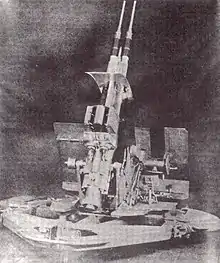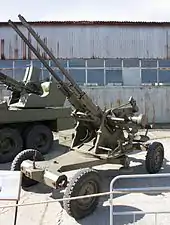| 3 cm MK 303 (Br) | |
|---|---|
 3cm MK 303 Flakzwilling, two 3 cm MK 303 in the twin mount | |
| Type | Anti-aircraft cannon |
| Place of origin | Nazi Germany |
| Service history | |
| In service | unknown |
| Used by | Nazi Germany |
| Wars | World War II |
| Production history | |
| Manufacturer | Krieghoff[1] |
| Produced | 1944–1945 |
| No. built | 222 (32 in 1944 and 190 in 1945)[1] |
| Variants | 3 cm Flakzwilling MK 303 (Br) |
| Specifications | |
| Mass | 185 kg (408 lbs)[2] |
| Length | 3.145 m (10 ft 3.8 in) |
| Barrel length | 2.2 m (7 ft 3 in) L/73 |
| Shell | 30×210mm |
| Caliber | 30 mm (1.18 in) |
| Elevation | -10°to ±85° |
| Traverse | 360° |
| Rate of fire | 400 rpm (cyclic) |
| Muzzle velocity | 1100 m/s (3,609 ft/s) M-Schos 900 m/s (2,953 ft/s) HE 950 m/s (3,117 ft/s) AP/HE[2] |
| Feed system | 15 cartridge clip |
The 3 cm MK 303 Flak and twin-mounted 3 cm MK 303 Flakzwilling (M44) were experimental 30 mm anti-aircraft guns developed in Nazi Germany. They fired the powerful 30x210mm round and only 222 were produced.[1] The gun was to be installed on Type XXI submarines as AA defense[3] and its use as AA defense replacing 2 cm Flak and 3.7 cm Flak weapons was also considered. The use of 3 cm M.K. 303 Flakzwilling on Flakpanzer IV "Kugelblitz" was considered, but rejected. The development began in late 1941[1] and production started in late 1944.
Post War Usage

Postwar PLDvK vz. 53
of Czechoslovak army
of Czechoslovak army
In the 50s, the MK 303 was produced in Czechoslovakia under the designation M53, with the clip feed replaced by a 10-round box magazine.[1] It was also used as armament of SPAAG M53/59 Praga.
References
- 1 2 3 4 5 "Авиапушки Кригхоффа. MG 301, MK 303". December 28, 2015. Archived from the original on July 14, 2019. Retrieved July 14, 2019.
- 1 2 "3 cm M.K.303 (Br) / 3 cm Flakzwilling M.K.303 (Br) : Germany (DEU)". armedconflicts.com. 26 January 2006.
- ↑ "dsub geschütze". www.ww2technik.de.
This article is issued from Wikipedia. The text is licensed under Creative Commons - Attribution - Sharealike. Additional terms may apply for the media files.